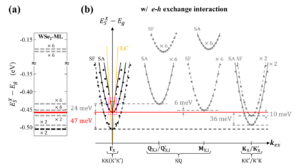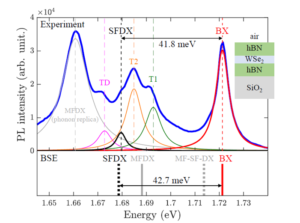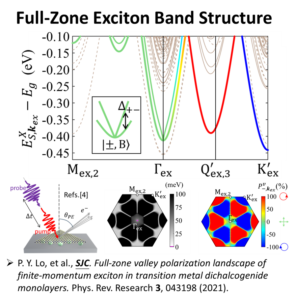Introduction
WannierBSE is an efficient computational package for solving the Bethe-Salpeter equation (BSE) for neutral exciton in 2D materials within the Wannier tight-binding (WTB) framework, implemented in the MATLAB (single-machine version) or C++ (parallelized version) languages. Technically, it takes advantage of efficient integration algorithm combined with cubic spline interpolation for fast and accurate construction of electron-hole (e-h) Coulomb kernels of BSE. WannierBSE can efficiently construct the matrix elements of BSE in the Wannier tight-binding scheme, based on the first-principles-calculated band structures and Bloch wavefunctions, and non-local dielectric functions obtained from either the DFT+GW or macroscopic electromagnetic theories. This enables WannierBSE to perform the multiscale simulations of excitonic spectra, exciton dipoles and exciton-light interactions of hybrid 2D materials under complex dielectric environments in an efficient, flexible and portable manner.
The WannierBSE package is developed to numerically solve the Bethe-Salpeter equation (BSE)

where 𝜖nk is the kinetic energy, ESQ is the energy of exciton state labeled by quantum number S with center-of-mass (CoM) wave vector Q, and the e-h direct and exchange Coulomb kernels read


where ψnk (r) is the single-electron wavefunction W (r1 , r2) = ∫ d3r’ε-1(r1,r’)V(r’–r2) is the screened Coulomb potential, with ε-1(r1,r’) being the inverse non-local dielectric function and V (r) = e2 / (4πε0|r|) being the bare Coulomb potential.
By formulating the e-h Coulomb kernels in the WTB framework, which unitarily connects the single-electron Bloch wavefunctions with the maximally localized Wannier function (MLWF) basis WjR (r) by

where j labels the orbital-like WFs, R indicates the unit cell that the WF locates at, and the coefficients Cj (n) (k) are determined by the WTB Hamiltonian

which is equivalent to the Kohn-Sham Hamiltonian ![]() represented in the WF basis. Within the WTB framework, the Bloch wavefunctions
represented in the WF basis. Within the WTB framework, the Bloch wavefunctions
ψnk (r) can be expanded by a small set (typically 101~102 ) of MLWFs, significantly reduces the computational costs of constructing e-h Coulomb kernels of the BSE.

Key features
- Portable within the MATLAB or C++ ecosystems.
- Flexibility of adopting the calculated band structures (from Quantum Espresso) and Wannier tight-binding matrix (from Wannier90) and dielectric screening from DFT+GW or multi-scaled electromagnetic theory.
- Multiscale simulation of exciton spectra of 2D materials in multi-layered dielectric environments.
- Flexible implementation on either single-node computers or high-performance supercomputers.
Developers
- Dr. Ping-Yuan Lo
- Dr. Wei-Hua Li
- Dr. Guan-Hao Peng
- Dr. Jhen-Dong Lin
- Dr. Vo Khuong Dien
- Mr. Ching-Hung Shih
- Mr. Kun-Yi Lin
- Prof. Shun-Jen Cheng


Publications with WannierBSE
- Guan-Hao Peng, Ping-Yuan Lo, Wei-Hua Li, Yan-Chen Huang, Yan-Hong Chen, Chi-Hsuan Lee, Chih-Kai Yang, Shun-Jen Cheng* (2019, Mar). Distinctive Signatures of the Spin- and Momentum-Forbidden Dark Exciton States in the Photoluminescence of Strained WSe2 Monolayers under Thermalization. Nano Letters, 19: 2299. (2019)
- Ping-Yuan Lo, Guan-Hao Peng, Wei-Hua Li, Yi Yang, Shun-Jen Cheng* (2021, Nov). Full-zone valley polarization landscape of finite-momentum exciton in transition metal dichalcogenide monolayers. Physical Review Research, 3: 043198. (2021)
- Wei-Hua Li, Jhen-Dong Lin, Ping-Yuan Lo, Guan-Hao Peng, Ching-Yu Hei, Shao-Yu Chen, Shun-Jen Cheng, The key role of non-local screening in the environment-insensitive exciton fine structures of transition-metal dichalcogenide monolayers, Nanomaterials, 13(11), 1739, (2023)
- Jhen-Dong Lin, Ping-Yuan Lo, Guan-Hao Peng, Wei-Hua Li, Shiang-Yu Huang, Guang-Yin Chen, Shun-Jen Cheng, Essential role of momentum-forbidden dark excitons in the energy transfer responses of monolayer transition-metal dichalcogenides, npj 2D Materials and Applications, 7, 51 (2023)
- Krisan Bryan, Teng-De Huang, Guan-Hao Peng, Feng Li, Oscar Javier Gomez Sanchez, Jhen-Dong Lin, Chun-I Lu, Chan-Shan Yang, Junjie Qi, Shun-Jen Cheng*, Ting-Hua Lu*, and Yann-Wen Lan*(2021, Feb).Selective Photoexcitation of Finite-Momentum Excitons in Monolayer MoS2 by Twisted Light. ACS Nano, 15: 3481. (2021)
- Yi-Hsun Chen, Ping-Yuan Lo, Kyle W Boschen, Chih-En Hsu, Yung-Ning Hsu, Luke N Holtzman, Guan-Hao Peng, Chun-Jui Huang, Madisen Holbrook, Wei-Hua Wang, Katayun Barmak, James Hone, Pawel Hawrylak, Hung-Chung Hsueh, Jeffrey A Davis, Shun-Jen Cheng, Michael S Fuhrer, Shao-Yu Chen, Efficient light upconversion via resonant exciton-exciton annihilation of dark excitons in few-layer transition metal dichalcogenides. Nature Communications 16 (1), 2935. (2025)
- Ching-Hung Shih, Guan-Hao Peng, Ping-Yuan Lo, Wei-Hua Li, Mei-Ling Xu, Chao-Hsin Chien, Shun-Jen Cheng, Signatures of valley drift in the diversified band dispersions of bright, gray, and dark excitons in MoS2 monolayers under uniaxial strains. Physical Review B, 111 (24), 245422 (2025) [Editors’ Suggestion]
If you are interested in further details about WannierBSE, please contact Prof. Shun-Jen Cheng by email: sjcheng@nycu.edu.tw.